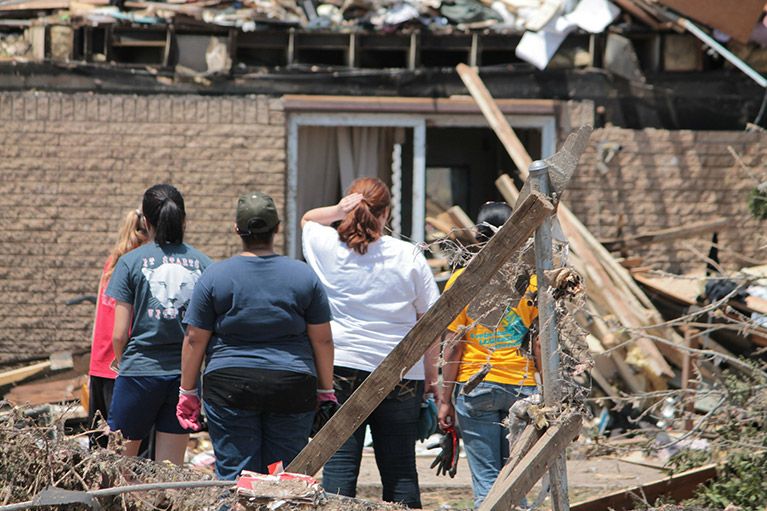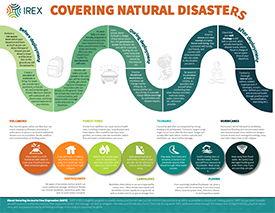How journalists can protect themselves before, during, and after natural disasters

As the number of natural disasters increases, more journalists are encountering unfamiliar and unpredictable risks and challenges. Natural disasters can take a physical and psychological toll on journalists. Although reporting on natural disasters is inherently risky, thorough planning and self-care can help improve journalists’ safety.
IREX’s Securing Access to Free Expression (SAFE) Initiative addresses safety through the lenses of digital identity, physical awareness, and psychosocial care by providing training in Central America, Eurasia, East Africa, South Asia, and the Middle East & North Africa. Here are tips from SAFE’s integrated safety training that can help local and international journalists safely cover natural disasters.
Before your deployment
Before embarking on an assignment to cover a natural disaster, perform an in-depth risk assessment and familiarize yourself with the situation you are likely to encounter on the ground. Educate yourself about the type of disaster you are about to cover and the risks that are associated with it—especially after-effects like aftershocks, landslides, and tsunamis that might occur well after the initial disaster.
Proper planning is key. For instance, dedicate time to identifying safe entry and exit points . If possible, get a briefing from emergency responders who are already on the ground. Make sure to identify who your contact persons on the ground will be.
Establish at least two channels of communication. Ideally, one of the channels should not require internet access. Get information on mobile coverage prior to your departure.
Approach your planning from a “nothing ever goes as planned” perspective. When packing your bags and equipment, create a checklist of materials to bring. Include extra provisions, a first-aid kit, and protective clothing and gear. Protect electronic devices with waterproof, antishock cases, and make sure to bring external batteries for all your electronic devices. Identify a safe house, a place you can go to in an emergency.
Also prepare yourself mentally and emotionally for what you are about to encounter at the disaster site. You might be confronted with severe destruction and human suffering. Make yourself aware of how this stress and anxiety might affect you, and prepare a “toolkit” for psychosocial self-care.
During your deployment
Upon arriving, identify who is in charge of rescue operations. Get their permission to enter the disaster site and ask for a security briefing. Only enter areas that have been cleared by first responders. Under no circumstances should you enter areas that have not been cleared by first responders. If possible, consult with local experts or rescue operations before entering areas with limited or no communication coverage or unknown road conditions.
While you are at the disaster site, practice situational awareness. Situations can change rapidly. If they do change, reassess whether you should stay or evacuate. If in doubt, always follow warnings by authorities and disaster experts on the ground.
When conducting interviews, always be aware of not just your own but also your interviewees’ emotional limits. Do not inspire false hope or make promises that you can’t keep. Instead, focus on listening to survivors’ stories. If you feel you are emotionally capable to do so in the moment, share knowledge with victims about trauma and its effects, while making sure to refer people to places where they can seek professional help and learn about strategies and tools for dealing with loss.
Continuously assess your own mental and emotional well-being. Staying connected with your family and friends or connecting with other journalists who can relate to your situation can help you cope with challenging situations.
After your deployment
Once you get closer to your departure date, make sure that your exit strategy is still safe to use. Go through the list of equipment you brought and make sure that you do not leave anything behind. When you get to the point of actually leaving the disaster area, do not forget to inform those in charge of rescue operations that you are leaving.
After returning to your office, conduct a thorough debrief with editors and solidarity groups. As preparation for future deployments to disaster scenes, do a retrospective assessment of which aspects of the safety plan did or did not work.

Be honest with yourself about your emotional and mental state after your return. Do not hesitate to seek out a counselor, a therapy group, or other professional help, especially if you think you might be experiencing trauma or PTSD. In addition, refresh your mental and emotional health by engaging in positive activities, such as meditation or exercising.
Download this infographic for more information about covering natural disasters as a journalist (PDFs in English and Spanish).